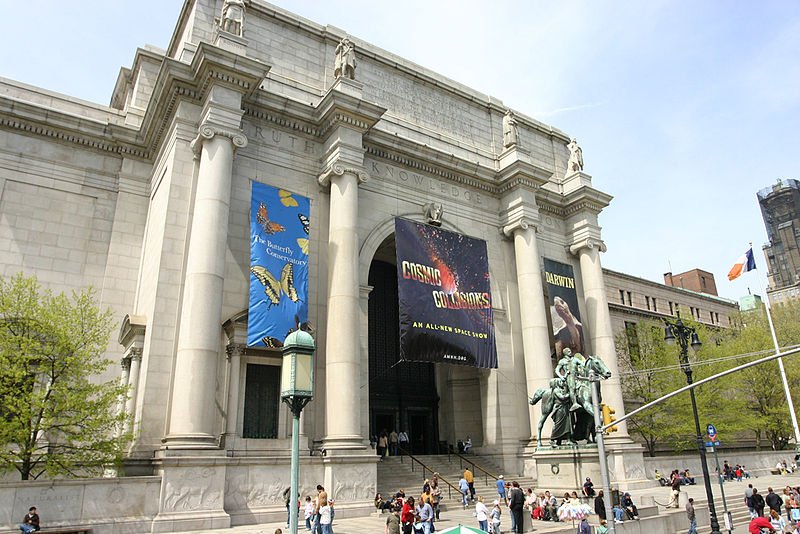 American Museum of Natural History, main entrance
American Museum of Natural History, main entranceSource: https://commons.wikimedia.org/wiki/File:American_Museum_of_Natural_History_New_York_City.jpg
Author: J.M. Luijt

The American Museum of Natural History is one of the two gigantic museums at Central Park, New York City. It is located on the Upper West Side of Manhattan, and spread out on 25 interconnected buildings housing 46 permanent exhibition halls, research laboratories, and its renowned library. The museum has a collection of over 32 million specimens and only a small fraction is displayed at any one time.
The American Museum of Natural History was founded in 1869. It was originally housed in the old Arsenal building in Central Park. Theodore Roosevelt Sr, father of the 26th US President, was one of the founders, along with William E Dodge Jr, Joseph Choate and JP Morgan. Its founding realised the dream of Dr Albert S Bickmore, who lobbied tirelessly for the establishment of a natural history museum in New York City. Backed by influential sponsors, his proposal was approved by the Governor of New York, John Thompson Hoffman, who signed the bill creating the American Museum of Natural History on 6 April, 1869.
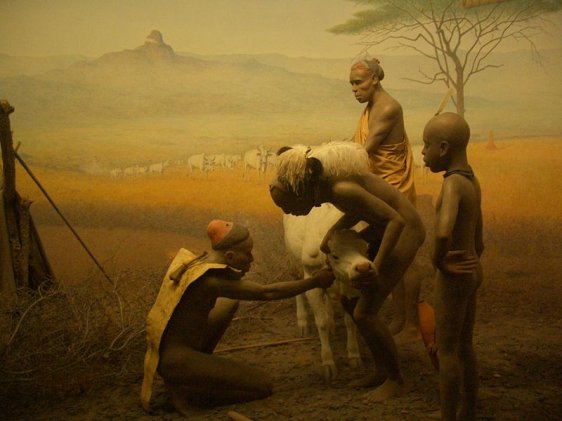 Hall of African Peoples diorama, American Museum of Natural History
Hall of African Peoples diorama, American Museum of Natural HistorySource: https://commons.wikimedia.org/wiki/File:Day117anaturalhistoryzi.jpg
Author: Chensiyuan

The first building for the museum was constructed in 1874. It is of neo-Gothic design by Calvert Vaux and Jacob Wrey Mould, with collaboration from Frederick Law Olmsted. Today it is hidden from view by the South range of the museum, designed in rusticated brownstone neo-Romanesque style by J Cleaveland Cady. The Roman entrance on Central Park West, the New York State Memorial to Theodore Roosevelt, is an over-scaled Beaux-Art monument by John Russell Pope, done in 1936. It leads to the Roman basilica where the dinosaur skeletons are housed. Here, we see a rearing Barosaurus defending her young from an Allosaurus. Their skeleton are huge enough not to be dwarfed by the monumentality of the basilica.
The 77th street foyer has recently been renovated, and renamed Grand Gallery. It is now gleaming white and illuminated by classic romanesque fixtures. A Haida canoe is suspended, giving the impression that it is afloat above the visitors. The Grand Gallery leads to the Hall of North West Coast Indians, the oldest existing exhibit in the museum.
One of the most renowned sections of the museum is its library. The Library of the American Museum of Natural History has one of the greatest natural history collections. Since its founding, it benefited from donations of private collectors as well as organisations.
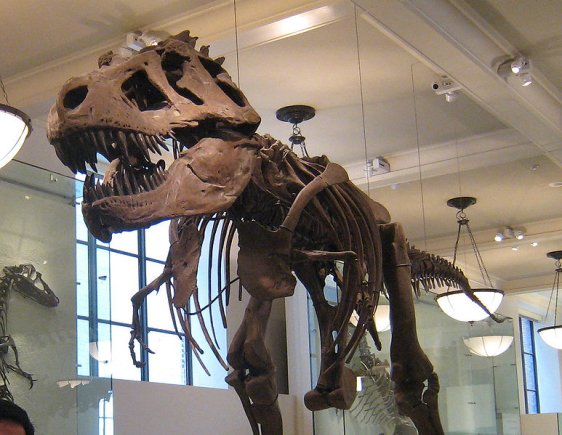 Skeleton of the Tyrannosaurus Rex at the American Museum of Natural History
Skeleton of the Tyrannosaurus Rex at the American Museum of Natural HistorySource: https://commons.wikimedia.org/wiki/File:AMNH-TRex_3.jpg
Author: Eqdoktor

The American Museum of Natural History has an impressive display of African, Asian and North American mammals, including a full-size model of a Blue Whale suspended in the Milstein Family Hall of Ocean Life. An entire floor is devoted to the vetebrate evolution, including the dinosaurs.
Apart from animals, the American Museum of Natural History also has an impressive collection of rocks, minerals and gems. These are housed in the Harry Frank Guggenheim Hall of Minerals and the Morgan Memorial Hall of Gems next to it. Of the over 100,000 gem specimens in the museum's collection, only a selection is on display.
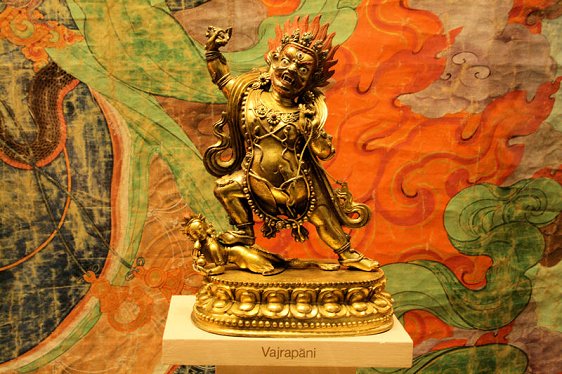 Tibetan deity Vajrapani at the American Museum of Natural History
Tibetan deity Vajrapani at the American Museum of Natural HistorySource: https://commons.wikimedia.org/wiki/File:Vajrapani.jpg
Author: Sujit kumar

The most famous gem in the museum is perhaps the Star of India, the largest blue sapphire in the world. It was discovered in Sri Lanka three hundred years ago in the sands of ancient river beds that continue to yield precious stones today. The Star of India was stolen in 1964 but was later recovered.
Another important gem in the collection is the Patricia Emerald, a 632 carot, 12 sided stone considered one of the world's most fabulous emeralds. It was discovered in the 1920's and named after the mine-owner's daughter. It is the biggest gem quality emerald that remains uncut.
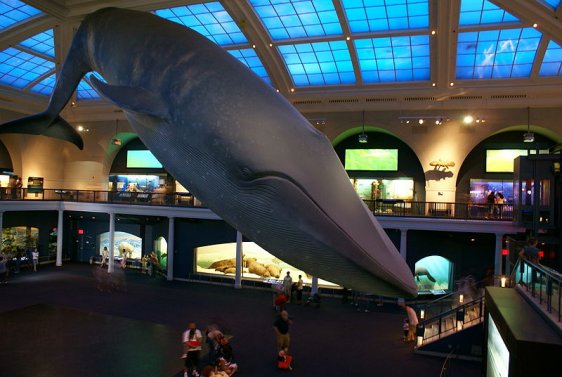 Full-size model of a blue whale at the American Museum of Natural History
Full-size model of a blue whale at the American Museum of Natural HistorySource: https://commons.wikimedia.org/wiki/File:Blue_Whale_Nat%27l_Hist_Museum.jpg
Author: Breakyunit

Other notable gems in the museum include the 596 pound Brazilian Princess topaz and the four and a half ton blue azurite/malachite ore from the Copper Queen Mine in Arizona. Perhaps the most awesome item is the Cape York meteorite, one of the largest iron meteorites in the whorld, which hit Greenland 10,000 years ago.
The Bernard and Anne Spitzer Hall of Human Origins, formerly known as the Hall of Human Biology and Evolution and originally known as the Hall of the Age of Man, was opened on 10 February, 2007. It presents an indepth investigation of human evolution wih displays showing the story of Homo sapiens.
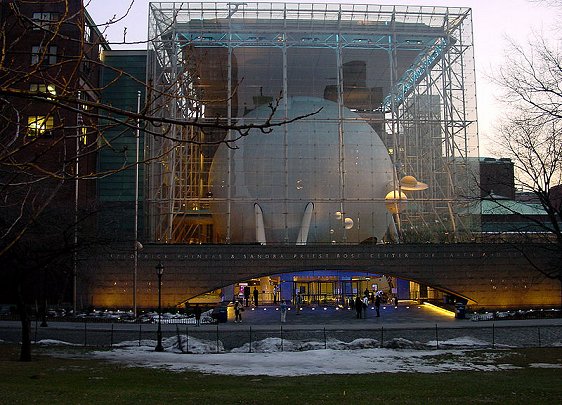 Rose Center for Earth and Space, American Museum of Natural History
Rose Center for Earth and Space, American Museum of Natural HistorySource: https://commons.wikimedia.org/wiki/File:Rose_Center_for_Earth_and_Space.jpg
Author: Spheroide

The Bernard and Anne Spitzer Hall of Human Origins has life-size dioramas of Australopithecus afarensis, Homo ergaster, the Neanderthal and the Cro-Magnon, showing each in its own habitat. Life size casts of important specimens, such as the 3.2 million-year-old Lucy, the 1.7 million year old Turkana Boy and cast of the Peking Man are all on display.
The American Museum of Natural History is located at 79th Street and Central Park West. It can be reached by the B and C lines of the New York City subway, with a station directly adjacent to the museum. The museum is open 7 days a week from 10:00am to 5:45pm, and closes only on Thanksgiving Day and Christmas Day. On every first Friday of a month, the Rose Center for Earth and Space is open until 8:45pm to accommodate the Starry Nights jazz festival.
 Latest updates on Penang Travel Tips
Latest updates on Penang Travel Tips

Copyright © 2003-2025 Timothy Tye. All Rights Reserved.

 Go Back
Go Back